Sugar is the number one ingredient used to add sweetness to all kinds of foods and drinks, but do you know all the different varieties and how to leverage them? All the types of sugar available on the market add up to an impressive number. Keep reading to find out the unique qualities of the most common ones and when it’s best to use each!

For both cooking and baking, there’s more to sugar than just sweetness. It can also provide texture, flavor, color, and it’s sometimes used for decorative purposes.
Did you know sugar used in bread dough will enhance the bread flavor, weakens the gluten structure, and helps the dough expand during baking, making it airier?
White sugar, brown sugar, and caster sugar are some of the most common kinds many of us already have in their pantries.
Have you ever heard of Turbinado sugar, or do you know the difference between light and dark brown sugar?
Yes, each sugar variety has something special to offer, and knowing them will definitely help you improve your cooking and baking skills!
Types Of Solid Sugar
Solid sugars are the most prevalent ones and, with some exceptions, they are extracted from sugar cane or sugar beets.
These two plants are processed in various ways, which gives us an array of sugars with different flavors and textures.
White Granulated Sugar

How it’s made – White sugar, also known as table sugar, is 100% sucrose extracted from either sugar beets or sugar cane.
Through several purification processes, the natural syrup known as molasses is completely removed.
Flavor – White granulated sugar has a neutral flavor, and a balanced level of sweetness.
Uses – Because of the neutral flavor, it won’t interfere with other ingredients in your recipe so you can use it for baking, cooking, and sweetening drinks.
Caster Sugar
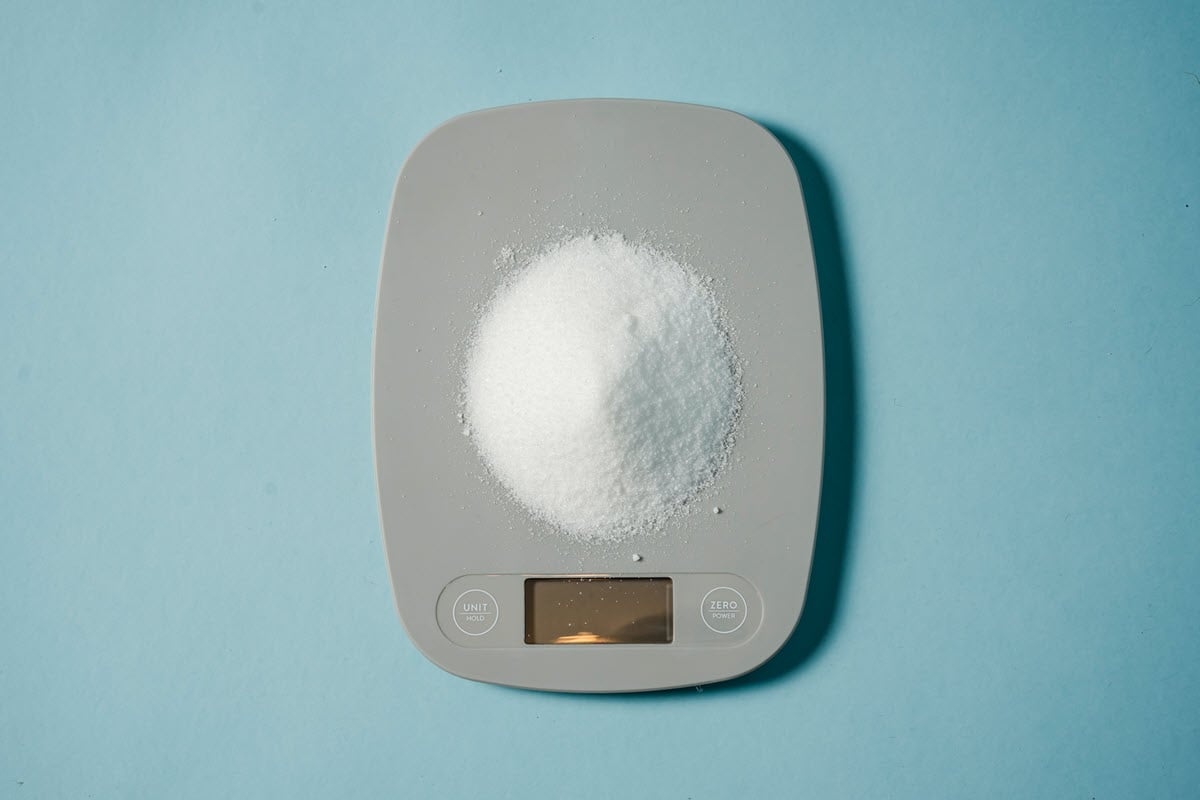
How it’s made – Caster sugar, bakers sugar, or superfine sugar all mean the same thing: a finely granulated white sugar.
Flavor – This is still white sugar, only with a smaller granulation. It has the same level of sweetness and the flavor is almost non-existent.
Uses – The superfine texture means it will dissolve more easily into batters and liquids, so use this one to make cocktails, syrups, puddings, buttercreams, mouse, and meringues.
Powdered Sugar
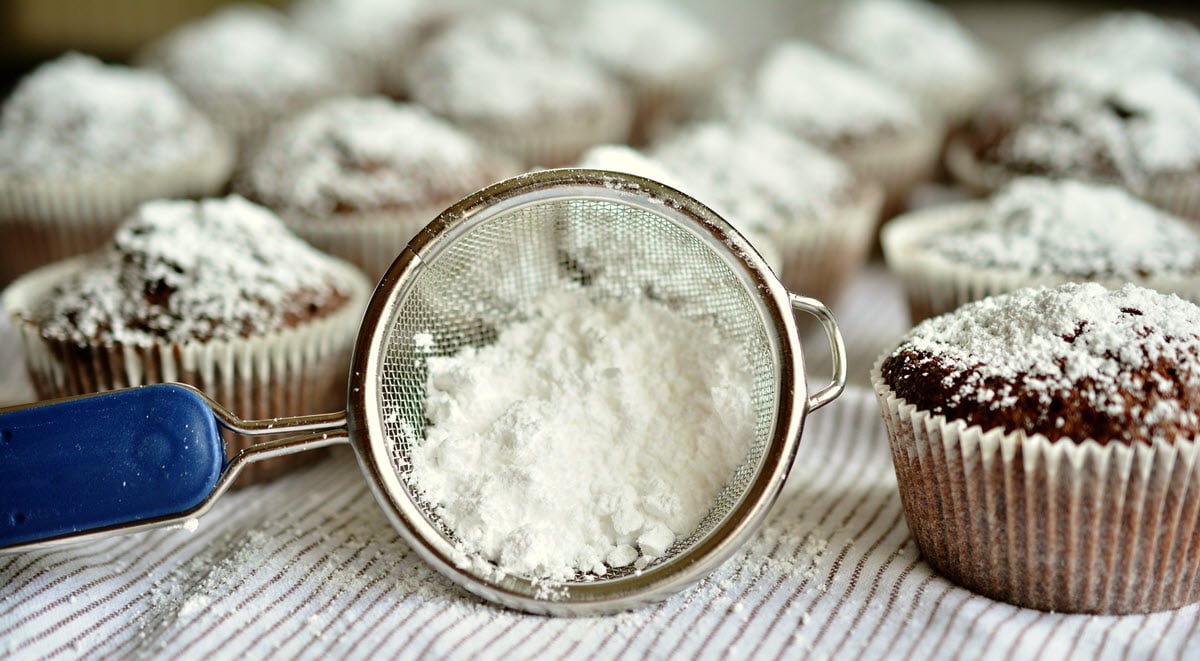
How it’s made – Powdered sugar is white sugar ground into a powder with a bit of added cornstarch to prevent clumping. You may also know it as confectioner’s sugar, or icing sugar.
Flavor – Same as white sugar, but with a much finer texture.
Uses – Because of the extra fine granulation, it’s commonly used to make icing, frosting, and for dusting baked goods.
We used powdered sugar to make the icing for this easy apple strudel recipe and it was a total hit. If you give it a try, you won’t regret it! We also love it on our Quick and Easy Pastry Tart for Easter, Mother’s Day and anytime you need to make a statement with a brunch dessert.
Whether it’s for Mother’s Day, Easter or anniversary, whipping up these Air Fryer Apple Roses with sprinkled powdered sugar is always a hit. Just a little bit of sweetness is all it needs. Santa Pancakes only need a little bit of sprinkle to make them magical!
Pearl Sugar
How it’s made – White sugar made from cane or beets but with larger sized crystals and a white, opaque color.
Flavor – Pearl sugar, also called coarse sugar, or decorating sugar, has the same neutral flavor and sweetness as white granulated sugar.
Uses – The larger granules are more resistant to dissolving and melting. Coarse sugar is typically used to decorate baked goods.
Sanding Sugar
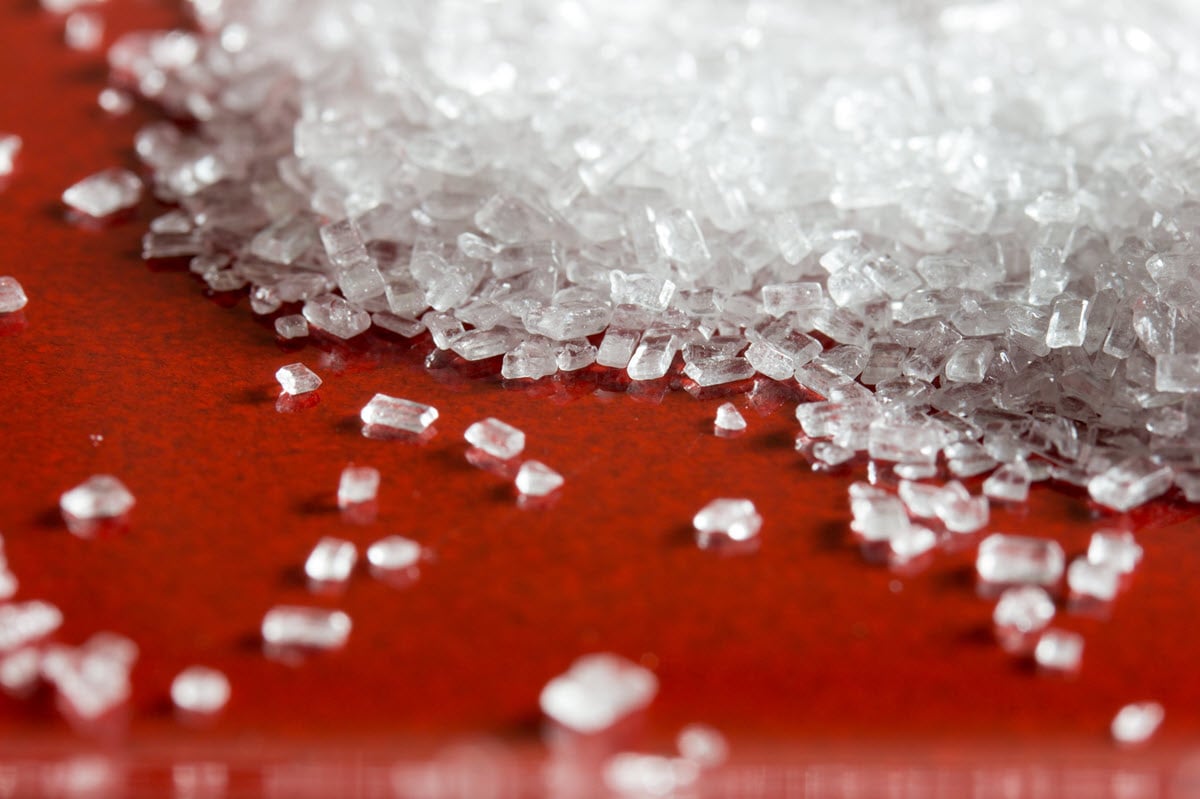
How it’s made – To add to the confusion, sanding sugar is also white sugar. Regarding the size of the crystals, it’s somewhere between table sugar and pearl sugar.
Flavor – Same as white sugar.
Uses – Sanding sugar has more polished granules compared to the other varieties of white sugar, so it’s more sparkly.
You can find it in various colors and just like pearl sugar, it’s typically used to decorate cookies and other baked goods, giving them a bit of extra crunch.
Jam Setting Sugar

How it’s made – Jam setting sugar is white sugar, with added pectin, and citric acid, a mixture which makes it easier for jams and jellies to set properly.
Flavor – The same neutral flavor as all other kinds of white sugar.
Uses – The primary use for jam setting sugar, also called gelling sugar, or simply jam sugar, is for making jams, jellies, and preserves.
The added pectin and citric acid will help your jams and jellies set as we did with our Mango Strawberry Freezer Jam.
It’s particularly useful for soft-fleshed fruits such as strawberries which have a lower pectin content.
Other fruits, such as oranges, have a higher levels of pectin, in which case you can get away with using regular white sugar.
In most cases, the ratio of fruit to sugar you should use is written on the packaging. The most common ratios you will find are 1:1, 2:1, and 3:1.
Cane Sugar

How it’s made: This type of sugar is made only from sugar cane and goes through minimal processing.
Compared to white granulated sugar, the crystals are slightly larger, and they have a slightly darker color.
Flavor: Cane sugar is still mostly sucrose. This means its sweetness and flavor are similar to the ones of white sugar.
Uses: You can use cane sugar for anything that calls for white sugar.
Raw Sugar

How it’s made: Raw sugar has a tricky name, as it might suggest it’s unrefined, or minimally processed. That’s not the case.
Raw sugar is actually refined, but goes through a single crystallization process, unlike white sugar that goes through several until all molasses is removed.
For raw sugar, a small amount of molasses remains, usually less than 2%. As a result, it will never have a pure white color, instead it varies from blond to light brown.
Flavor: This type of sugar as a very subtle molasses flavor and in most cases it won’t significantly change the taste of food.
Uses: You can use raw sugar for any recipe that calls for white sugar. It’s a bit more resilient to heat, so it works nicely as a topping for baked goods.
It’s also a natural way to enhance the color of the foods you are making.
Light Brown Sugar
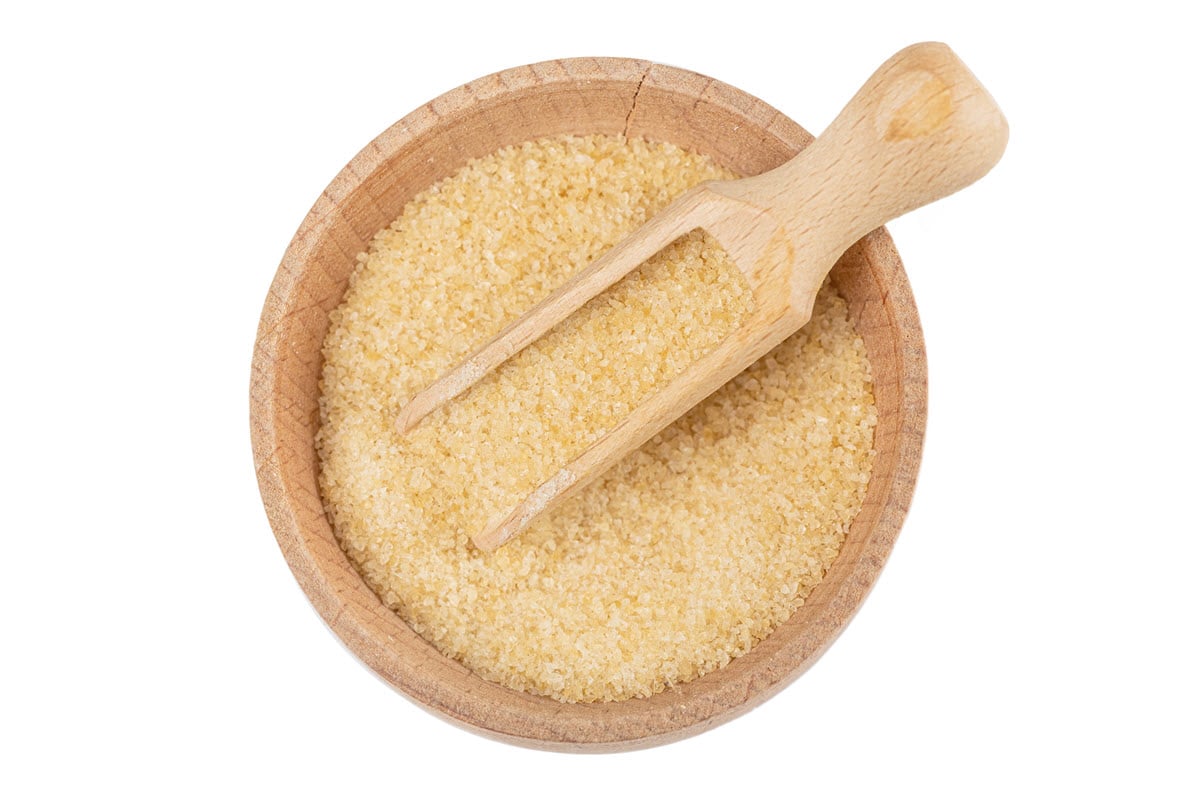
How it’s made: Light brown sugar (you might also find it under the name ‘golden sugar’) is white refined sugar with a small amount of molasses added back in after the refining process.
Flavor: Golden sugar has an airy texture and also a bit of moisture because of the molasses it contains.
The flavor offers hints of caramel and its sweetness level is similar to white sugar.
Uses: That extra moisture and caramel notes makes it wonderful to use for baked goods such as cookies, cupcakes, and brownies.
Make sure to make the Air Fryer Granola that is the perfect healthy kickstart to your day! Air Fryer Sweet Potatoes use either light or dark brown sugar, depending on how much sweetness level you desire.
It’s also perfect for adding sweetness to sauces and glazes, as well as savory dishes.
Dark Brown Sugar

How it’s made: Dark brown sugar is produced in the same way as the light brown variety.
The major exception is this type contains a higher quantity of molasses, which gives it a darker color.
Flavor: Dark brown sugar has more molasses than light brown. This means it has more moisture and often clumps. The caramel flavor is also more noticeable.
Uses: You can use it for any dessert or recipe where you’d use light brown sugar if you want a deeper color and a richer flavor.
The extra moisture and pronounced caramel aroma is excellent for various desserts, sauces, marinades, and rubs.
We love using brown sugar for savory recipes like bacon wrapped mushroom kabobs and Air Fryer chicken enchiladas, but also for baked desserts such as these amazing coconut muffins, or these crunchy and chewy sunflower seed butter cookies.
Note: Free-flowing brown sugar has a smaller granulation and less moisture compared to regular brown sugar.
It goes through a special process that removes a good amount of moisture.
This ensures it doesn’t clump and is free-flowing, just like white sugar. It’s easier to measure and can be used as a white sugar substitute in any recipe where you want to enhance color and add some caramel flavor.
Demerara Sugar
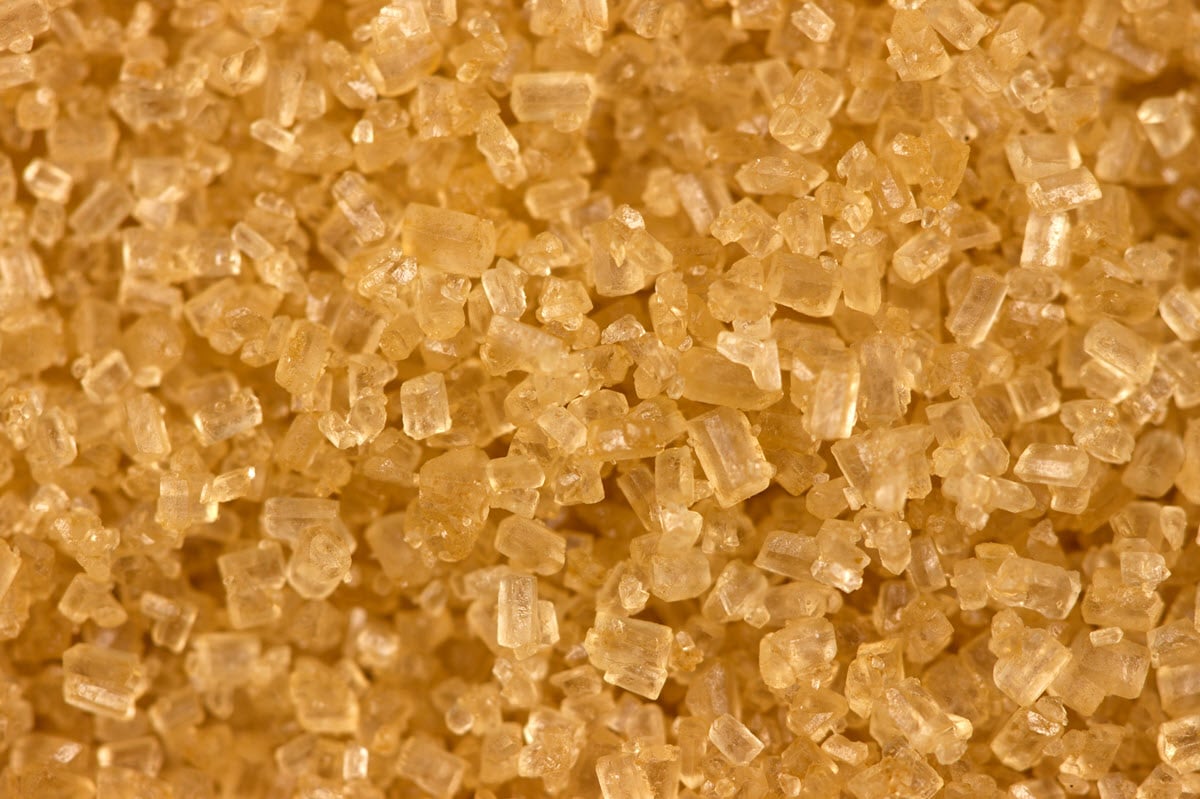
How it’s made: Demerara is a type of brown sugar that goes through a single crystallization process.
It has large granules and a small amount of moisture, as it contains a bit of molasses.
Flavor: Demerara has a crunchy texture and a delicious flavor of molasses and toffee, with subtle tones of caramel.
Uses: Because of the large crystals, Demerara is wonderful for adding a crunchy topping to baked goods such as muffins, scones, and crème brûlée, and for sweetening drinks.
Turbinado Sugar
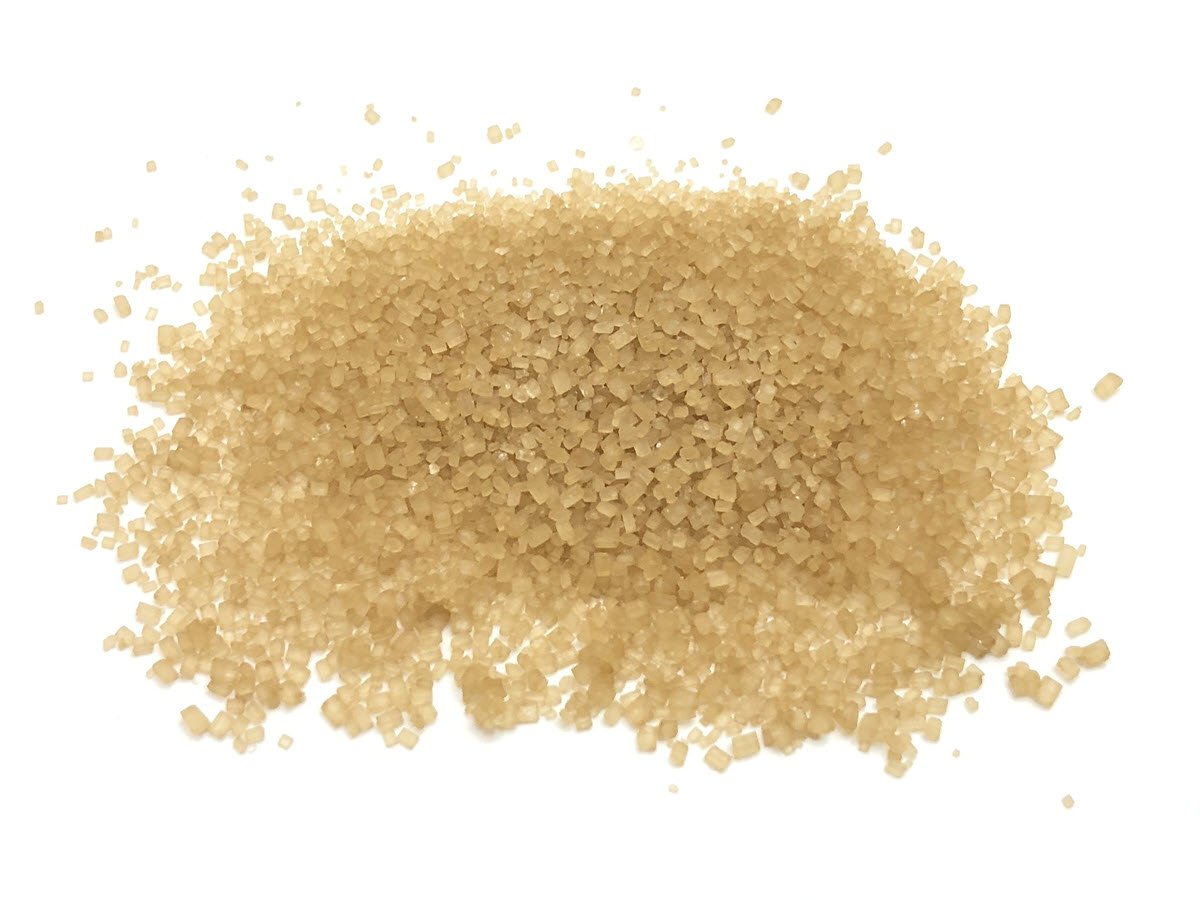
How it’s made: Turbinado is also a brown sugar variety that is minimally processed and retains a bit of molasses.
You might wonder what’s the difference between Turbinado and Demerara sugar? Turbinado has more molasses, and the size of the granules is slightly smaller compared to Demerara.
Flavor: Compared to Demerara sugar, Turbinado has a more intense molasses flavor. Demerara, having a lower content of molasses, offers a more subtle toffee-caramel aroma.
Uses: You can substitute Demerara for Turbinado and vice versa. The latter one having smaller crystals will be less crunchy, but it will offer a stronger molasses flavor.
We used Turbinado sugar to top these fresh and tender blueberry muffins and the extra flavor was more than welcomed.
Muscovado Sugar
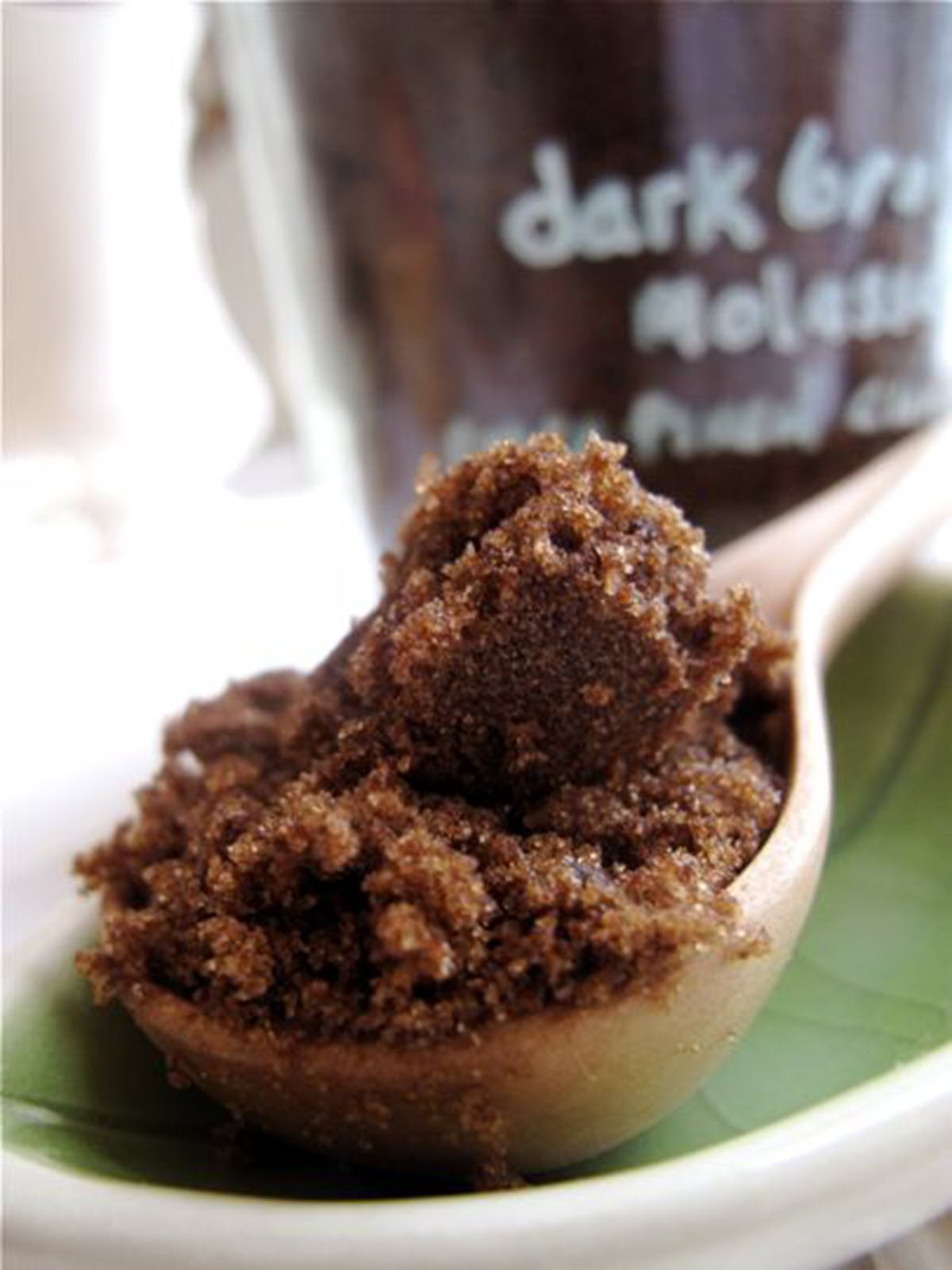
How it’s made: Muscovado is a type of unrefined sugar with a high content of molasses. It is very moist, has a dark brown color, and clumps easily.
To make it, the sugar cane extract is heated, and the liquid is evaporated, leaving behind only the sugar residue. Molasses is not removed during this process.
Flavor: With the texture of wet sand, Muscovado sugar has a strong molasses flavor, with subtle toffee undertones and a smoky aftertaste.
Uses: The complex aroma of Muscovado sugar with notes of toffee, and smokiness makes it particularly suitable for pairing with savory dishes and darker baked goods such as gingerbread and brownies.
It’s also commonly used to deepen the flavor of BBQ sauce, meat marinades and glazes, to make toffee and caramel, and as a sweetener for coffee, cocoa, and other hot drinks.
There are similar types of minimally processed sugars with a high molasses content you might find available in your area.
You can use any of these as a substitute for Muscovado sugar:
Jaggery – Originating in India, jaggery also has a high moisture content that can go up to 20% and it’s made from date palm or sugar cane.
Sucanat – This sugar is a brand name and is the short version of ‘sugar cane natural’.
Rapadura – The Brazilian counterpart of Muscovado, is made via low heat dehydration in which only the water is removed, preserving a high amount of nutrients and molasses.
Panela – An unrefined sugar, traditionally produced in Central and Latin America. Made similarly to Muscovado, Panela is sold in various forms, such as liquid, granulated, and even solid blocks.
Coconut Sugar

How it’s made: Coconut sugar is made from coconut palm sap, a naturally sweet liquid that circulates in the coconut plant.
The liquid sap is collected from the coconut plant. Then, it’s heated until most of the water evaporated and what remains is known as coconut sugar.
The size of the sugar granules varies, and it has a rich brown color.
Because of the minimal processing, coconut sugar retains trace amounts of nutrients although it has a similar number of calories compared to regular table sugar.
Flavor: Coconut sugar has a strong caramel taste, pretty similar to that of brown sugar and molasses.
Uses: Because of the similar flavor, you can use coconut sugar as a substitute for brown sugar, or even white sugar in a 1:1 ratio.
It will add an earthy aroma to your desserts, savory dishes, or drinks.
Types Of Liquid Sugar
Liquid sugar offers another way to add sweetness to food and drinks, being more useful for the latter category, since it dissolves easily.
Don’t mistake these types of liquid sugar with natural alternatives, such as honey and agave syrup.
Liquid sugar varieties contain more or less refined sugar, be it white or brown.
Liquid Sugar / Simple Syrup

How it’s made: Liquid sugar is granulated sugar completely dissolved in water.
The one made from white granulated sugar is the most common, although you might find liquid sugar made from various brown sugars.
The most popular name for liquid sugar is simple syrup and the ratio of sugar and water is 1:1.
Flavor: The flavor of liquid sugar depends on the type of granulated sugar that was used to make it.
If it was white sugar, the flavor is neutral, and if a type of brown sugar is the key component, expect a toffee-like flavor.
Uses: Simple syrup contains dissolved sugar so it can be easily mixed into drinks such as coffee, cocoa, tea, and cocktails.
This is the most common use, although it can substitute granulated sugar for savory dishes and baked goods.
Don’t forget to adjust the amount of liquids used in the recipe since liquid sugar is usually 50% water.
Sometimes, commercial versions of liquid sugar have added glucose and fructose which can make the end product taste sweeter than plain table sugar.
Invert Syrup
How it’s made: Invert syrup, a.k.a golden syrup is made by boiling white granulated sugar with an enzyme called invertase, or an acid.
This process breaks down sucrose molecules into its essential components: glucose and fructose.
You can encounter two types of invert syrup: full invert (if approximately 90% of the sucrose is inverted), and medium invert (if 50% of the sucrose splits).
The latter is the most common type, containing about 50% invert sugar (equal parts of fructose and glucose), and 30 to 40% sucrose.
Flavor: Obviously, invert syrup doesn’t really have a flavor, standing on the neutral side, just as the table sugar it’s made from.
Regarding sweetness, an invert sugar with approximately 75% total sugars is on the same level as plain white sugar.
Uses: Invert syrup has the same advantage as simple syrup: it easily blends into drinks, so you can use it to sweeten all of your favorite beverages, and even sauces, marinades, and salad dressings.
Molasses

How it’s made: Molasses is a liquid byproduct of sugar refining and it comes in three strengths.
Light molasses is made using a single boiling process, dark needs to boil two times, and blackstrap is what you get after a third boil.
Flavor: Molasses has a sweet, earthy flavor with hints of smokiness.
Light molasses has a more subtle aroma, while medium molasses is more robust. Blackstrap molasses has a specific bitterness and is less sweet than the first two.
Uses: Molasses has a rich flavor and is great for adding moisture, so it pairs well with baked goods, pastry, and savory dishes.
It’s highly appreciated as a topping for waffles, pancakes, and French toast. Even more, you can use molasses to enrich sauces, marinades, glazes, and salad dressings.
Molasses is a secret ingredient in our baked beans recipe and we also love how it adds to the flavor when making gingerbread granola.
F.A.Q
You can totally substitute brown sugar for white sugar! The ratio is 1:1 so this means whatever amount of brown sugar your recipe calls for, replace it with an equal amount of white sugar.
However, expect the end result to have a less intense flavor and perhaps be slightly drier. Brown sugar has that pleasant caramel aroma and the molasses will add some moisture which white sugar doesn’t have.
A closer substitution would be to try some of these combinations:
1 Cup of granulated sugar + 1 tablespoon of molasses = 1 Cup of brown sugar
1 Cup of granulated sugar + 1 tablespoon of honey or maple syrup = 1 Cup of brown sugar
Technically, all sugars extracted from plants, such as sugar cane and sugar beets, are refined. Unrefined sugar is THE LEAST refined. Confusing, right?
Let’s start with refined sugar. It’s made through a process that involves remelting, filtering, evaporation, and centrifuging.
The final product contains anywhere between 91% to 99.9% sucrose for solid sugar and 50% to 80% sucrose for liquid sugar.
Unrefined sugar also comes from cane or beet juice which goes through a boiling process to remove most of the water.
Unlike the refined kind, it is NOT centrifuged and, as a result, it retains the molasses, which gives them a darker color and specific taste. Typically, unrefined sugars contain from 8 to 14% molasses.
Muscovado is one of the most popular unrefined sugars and you can read more about it, as well as similar sugar varieties in the dedicated section above.
Simple syrup also contains liquid, so it will dissolve easier compared to solid sugar.
As a general rule of thumb, 1 teaspoon of granulated white sugar equals 1/5 teaspoons of simple syrup.
Last but not least, if you choose to replace liquid sugar with solid sugar, you will also need to lower the amount of other liquid ingredients in the recipe.
Final Thoughts
Whatever recipe you plan to make, there’s a type of sugar that works best for it.
Now that you know the traits of the most commonly used sugar varieties, experimenting in the kitchen will be even more fun!
Hi!
Ginny Collins is a passionate foodie and recipe creator of Savor and Savvy and Kitchenlaughter. Indoors she focuses on easy, quick recipes for busy families and kitchen basics. Outdoors, she focuses on backyard grilling and smoking to bring family and friends together. She is a lifelong learner who is always taking cooking classes on her travels overseas and stateside. Her work has been featured on MSN, Parade, Fox News, Yahoo, Cosmopolitan, Elle, and many local news outlets. She lives in Florida where you will find her outside on the water in her kayak, riding her bike on trails, and planning her next overseas adventure.





Leave a Reply